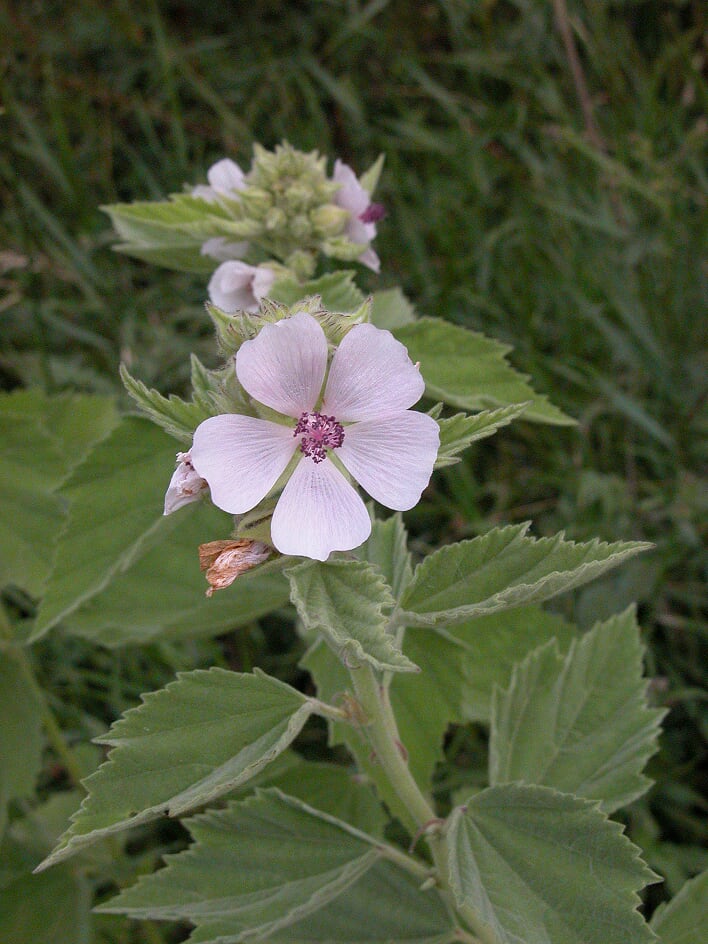Marshmallow
Althaea officinalis L.
Malvaceae
The marshmallow is a downy perennial plant that can reach 1.5 meters in height and offer many pink flowers in the summer. Native to France, it is most often found in the tall grasses on the Atlantic side, often close to the sea.
The marshmallow belongs to the botanical family Malvaceae, The name comes from the ancient Greek malássô which means to soften.This is particularly appropriate for the marshmallow, which contains a good deal of mucilage* – a component that forms an emollient, anti-inflammatory gel when in contact with water.
The medicinal qualities of the marshmallow have been known since antiquity, as we can see from its genus name Althaeawhich is derived from the Greek althaïnô meaning “to heal.” Theophrastus, an ancient Greek philosopher and botanist, was among the first to site the marshmallow as a cough remedy when prepared in sweetened wine. The flower is one of what the French call “pectoral” species, plants prescribed for pulmonary issues, along with common mallow, poppy, catsfoot, coltsfoot, and violet. This recipe was registered in the pharmacopeia until 1965.
The marshmallow’s mucilage also gives it its healing and softening properties. It is used for calming irritated stomachs, healing wounds and stings, or soothing itches.
The root, peeled and dried, is also traditionally used to relieve teething pain. The plant’s mucilage becomes a soothing gel when put in contact with saliva, helping to ease toothaches for infants who chew on the marshmallow “rattles.”
But in the Middle Ages, there was another, more sordid use for the properties of marshmallow. A form of judgement called trial by ordeal could be performed using a red-hot iron, or ferrum candensThe accused had to walk nine paces holding a hot iron bar**. Their hands were then bandaged in a leather bag that was sealed by the judge. To see if the accused was innocent or guilty, they opened the bag after three days to inspect the evolution of the wound. A “beautiful,” or well-healed wound proved innocence, as God had given his aid to the accused. An “ugly,” wound was a sign of guilt. It was reported that smearing one’s hands with marshmallow sugar before the test would protect the skin and promote healing, and therefore innocence!
At last, in the nineteenth century, the marshmallow gave its name to a traditional confection based on egg whites, sugar, and arabic gum. Today, the marshmallow root in this candy has been replaced by gelatin, which is cheaper and allows for industrial production.
Even if you don’t have a sweet tooth, the marshmallow is edible and is considered a wild vegetable. The leaves can be cooked, the flowers added to salads, and the cooked roots can be eaten like salsify.
Traditional marshmallows
2 egg whites
25 g marshmallow root
510 g arabic gum
510 g sugar
1.25 L water
Cornstarch
- Soak the roots in water for 8 hours in the refrigerator.
- Bring them to boil for 10 minutes.
- Filter
- Add the arabic gum to the hot water and stir until it dissolves.
- Add the sugar to thicken the mixture, stirring constantly.
- Whip the egg whites until they hold their shape and add them to the hot mixture.
- Continue to stir on low heat.
- Sprinkle a pan with cornstarch and pour the mixture in.
- Let cool, and cut into pieces.
* Up to 20% in the flowers and even 30% in the roots
**This practice is the origin of the French saying “j’en mettrai ma main au feu,” “I would put my hand in fire,” used when someone is very sure that what they say is true.
